by Linda Sue Park, illustrated by Debbie Ridpath Ohi; Simon & Schuster Books for Young Readers; 2020.
Years in the making, the eagerly-anticipated Gurple and Preen picture book began with Debbie Ridpath Ohi‘s blog, which features broken-crayon art and has grown to enjoy immense popularity. On the blog, Debbie features found object art–broken crayons–that inspire humorous, playful illustrations. I’m pleased to celebrate the launch of Gurple and Preen, a collaborative effort between Debbie and Newbery Award and New York Times bestselling author and friend, Linda Sue Park, with an interview featuring both creators!
“You never know what will come out of a broken crayon.”—Debbie Ridpath Ohi
Why this book? Why will it matter to kids
What started out as a fun art exercise turned into a winning idea that children embraced across Canada (where Debbie lives), the United States, and many other nations. Kids tried creating their own broken-crayon art, and many of them posted their drawings on Twitter. Debbie’s artistic brainstorm caught the attention of not only educators and parents, but also the publishing world. Debbie tried writing her own broken-crayon story, but had trouble coming up with one she wanted to illustrate. When Debbie and Linda Sue Park were on the faculty at the SCBWI Northern Ohio Regional Conference in 2017, they talked about Debbie’s broken -crayon art, and Linda Sue kindly agreed to try writing a story. Debbie loved it! Now, young readers can revel in a creative fantasy based on broken-crayon characters who work together using their imaginations and creative energies to turn a less-than-ideal situation into a satisfying one.
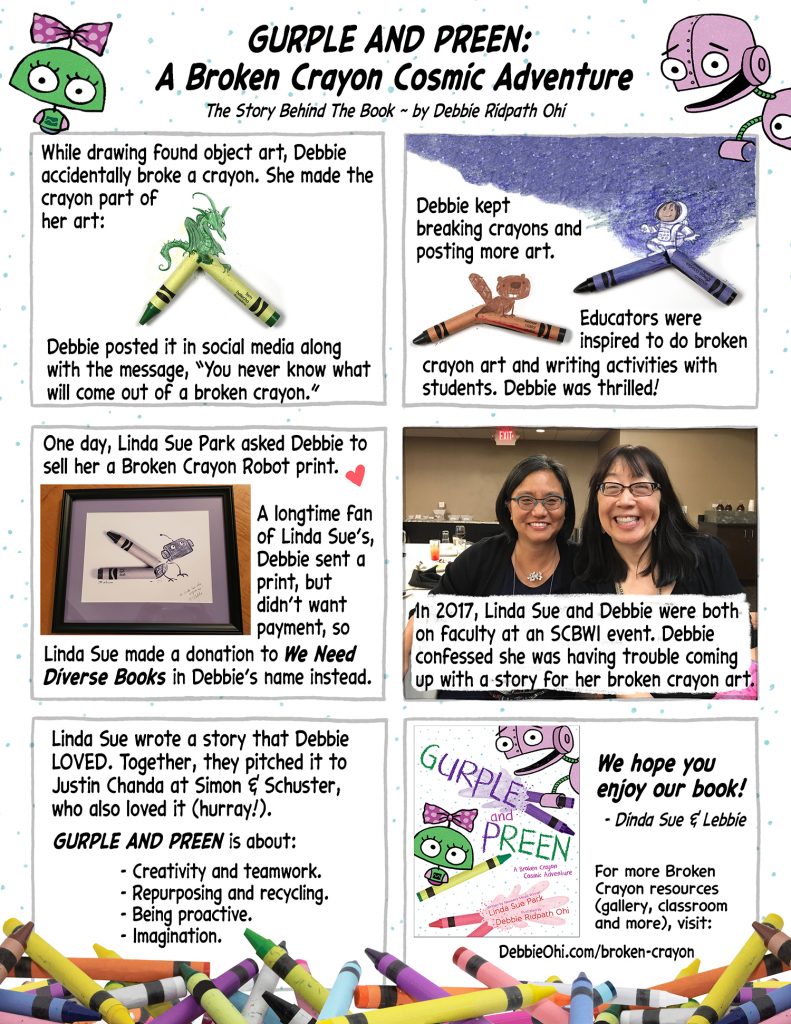
Created by Debbie Ridpath Ohi
Grade level: Grades Pre-K-3
Social-Emotional Learning Themes
Creativity, empathy, compassion, tenacity, perseverance, persistence, inspiration, encouragement, acceptance, perspective, self-reliance, respect, effort, understanding, connection, self-assurance, dedication, resourcefulness, self-awareness, diligence, fortitude, integrity, trustworthiness, loyalty, empowerment, generosity of spirit, collaboration
Content Area Connections
English Language Arts, Science, Art
Using This Book in the Classroom
Hit the Ground Running
Ready Resources for Educators, Homeschoolers, and Parents
An extensive Classroom Guide to Gurple and Preen is offered here.
Debbie’s “Broken Crayon Classroom Resource” can be found here.
View a wide array of activities related to Gurple and Preen on a page dedicated to the book on Debbie’s massive, resource-laden website.
An interview in which designer Laurent Linn explains how the Gurple and Preen cover was designed can be found here.
Write Away!
Ideas to prompt writing
Debbie remembers creating her first piece of broken-crayon art. “I was looking around my office for something small I could use for found object art. At first I was going to do my usual found object exercise by taking the broken green crayon I found and making it part of my drawing. But then I thought how much more interesting to have something crawling out of the broken bit.” Debbie photographed the broken bit first and then added the illustration afterward. She posted it on social media along with “You never know what will come out of a broken crayon” and the overwhelmingly positive response inspired her to keep creating broken crayon art. Educators shared broken crayon art created by students in their libraries and classrooms. Students wrote stories to go with the art. Sometimes (especially after reading Sam & Eva, a picture book about creative collaboration which Debbie wrote and illustrated, students collaborated on broken crayon drawings.
Combine writing with visual art by having students write stories about their broken crayon art creations following the reading of Gurple and Preen. Consider pairing the reading of this book with Sam & Eva and follow with a collaborative art and writing exercise. Post under a banner that states, You never know what will come out of a broken crayon–or a collaboration.
As they are boarding the repaired spaceship, the Commander reflects on the successful repairs, and Gurple translates for Preen: “They did it the way you do anything hard. Step by step by step.” Ask students to write about a time when they conquered something difficult by tackling it step by step by step. Make a vertical staircase as a background for the written reflections and post on a wall in the classroom or library.
Debbie is the illustrator of several books, including the popular I’m… series written by Michael Ian Black: I’m Bored, I’m Worried, I’m Sad, and the upcoming I’m Sorry. Read one or all of the books in the I’m series and follow up with a writing exercise/broken-crayon art activity related to the theme of feelings. Share, discuss, and display.
Find activity sheets for young writers on Debbie’s website here.
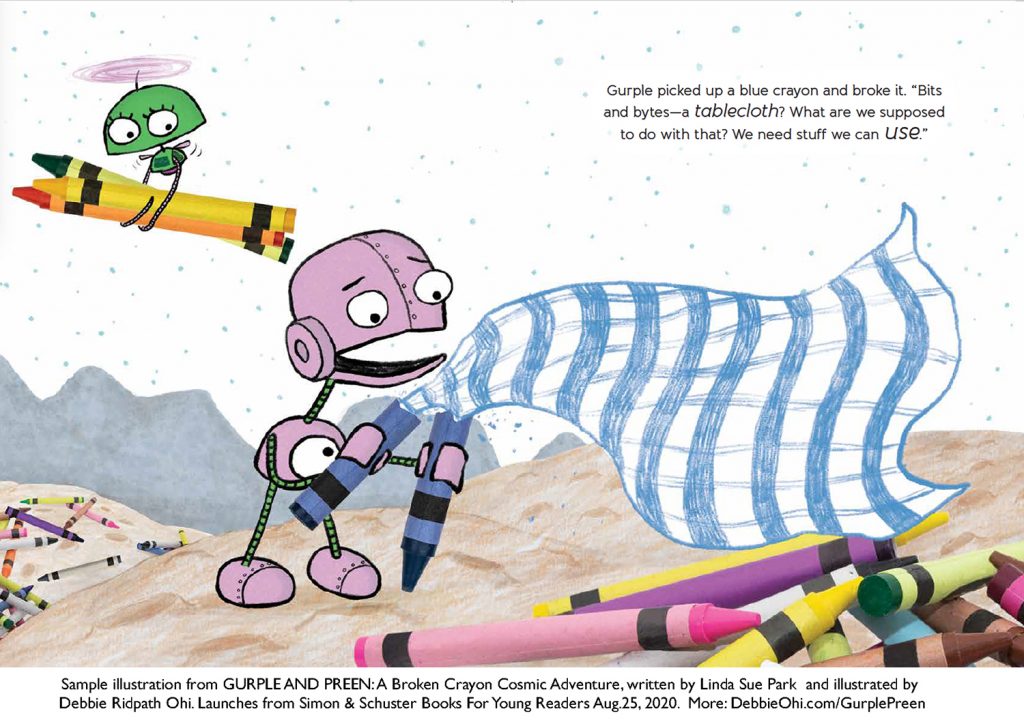
Poetry Break
Related poetry to recite before or following the reading of this book
Poetry breaks fit perfectly into brief moments in the day—from opening or closing the daily morning meeting to lining up for lunch; from zipping up backpacks and jackets to transitioning from one subject to the next. Reading a poem typically takes less than a minute, yet it can introduce or reinforce a concept, celebrate language, exemplify rhythm, enhance vocabulary, expand understanding, increase attention span, initiate reflection, or summon a giggle. And, poetry soothes the spirit.
Listed below are selected poems and poetry collections related to color and art:
- Hailstones and Halibut Bones: Adventures in Poetry and Color by Mary O’Neill, illustrated by John Wallner
- “I Love to Draw” in Climbing Shadows: Poems for Children by Shannon Bramer, illustrated by Cindy Derby
- my cold plum lemon pie bluesy mood by Tameka Fryer Brown, illustrated by Shane W. Evans
- “Paint the Sunset” in Thanku: Poems of Gratitude edited by Miranda Paul, illustrated by Marlena Myles
And Then There’s This…
Enrichment activities, related books, online resources, craft projects, and ideas for further study
Extensive free print-ready resources for Debbie’s books can be found here, including “Learning From Home Activities,” “Summer Reading Resource,” print-ready posters and bookmarks, activity sheets, and teachers’ guides for her books.
Find activity sheets for young illustrators on Debbie’s website here.
Find activity sheets for young cartoonists on Debbie’s website here.
Book Review and Recommendation templates for student use designed by Debbie can be found here. (Scroll down the page!)
Minecraft-themed Literacy Activities created by Debbie can be located here.
A calligraphy template, how-to directions for creating masks and puppets, gift cards, holiday-themed activities, and more are available on Debbie’s learning-friendly website.
Visit Crayola’s At-Home Learning page to download free family projects, parent resources, and at-home learning videos.
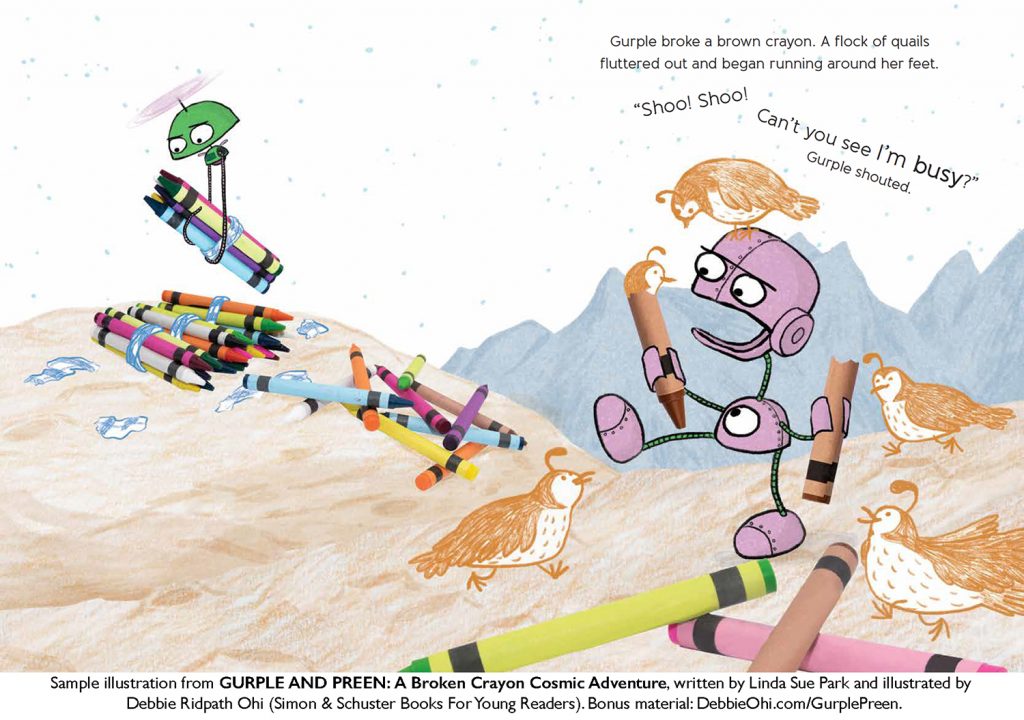
Related Books of Interest
- The Day the Crayons Came Home by Drew Daywalt, illustrated by Oliver Jeffers
- The Day the Crayons Quit by Drew Daywalt, illustrated by Oliver Jeffers
- Draw the Line by Kathryn Otoshi
- My Blue Is Happy by Jessica Young, illustrated by Catia Chen
- Red: A Crayon’s Story by Michael Hall
- When Pencil Met the Markers by Karen Kilpatrick and Luis O. Ramos, Jr., illustrated by Germán Blanco
Meet the Illustrator
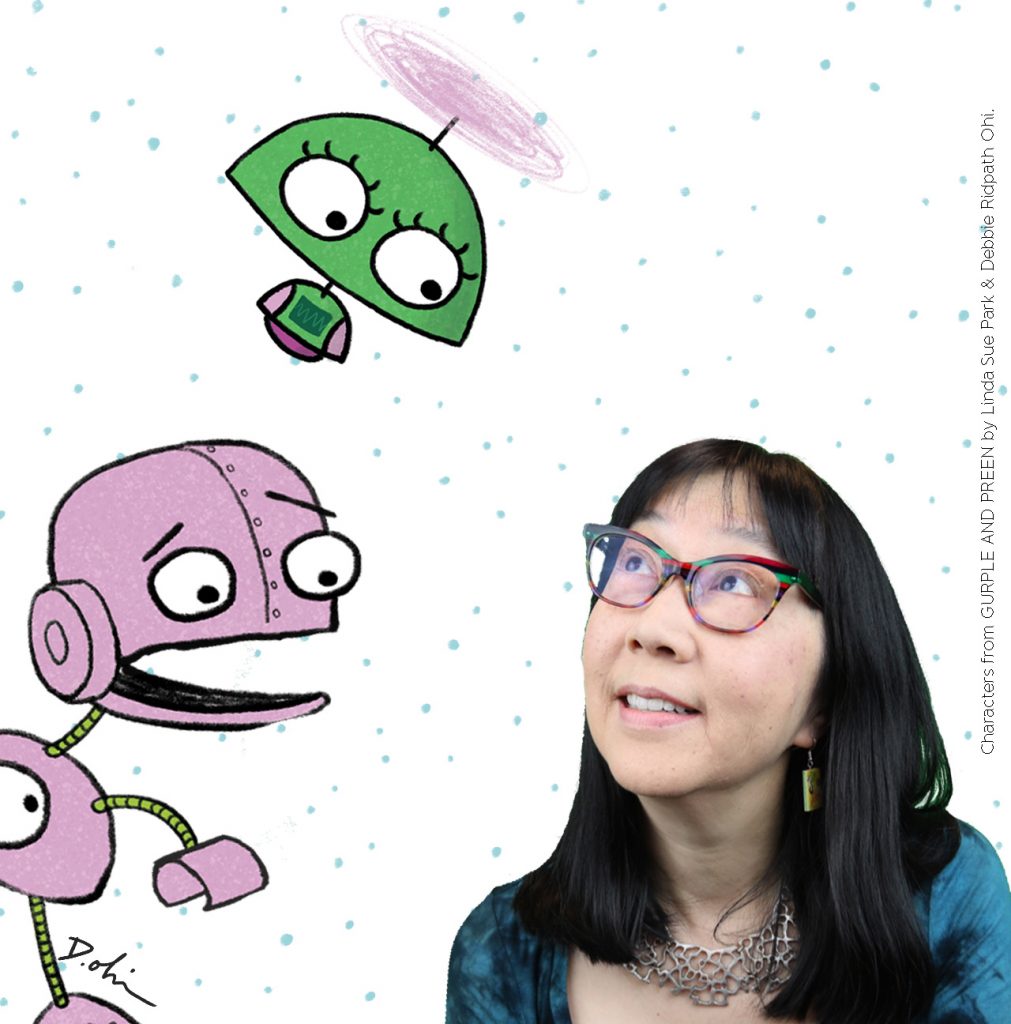
Debbie Ridpath Ohi is the author and illustrator of Where Are My Books? and Sam & Eva (Simon & Schuster Books for Young Readers). Her illustrations also appear in books by Judy Blume, Michael Ian Black, Linda Sue Park, Rob Sanders, Lauren McLaughlin, Aaron Reynolds, and others. She breaks crayons and draws with her food. For more info about Debbie and upcoming projects, visit her website.
Meet the Author

Photo credit: Sonya Sones
Linda Sue Park is the author of many books for young readers, including the 2002 Newbery Medal winner A Single Shard; the NYTimes bestseller A Long Walk To Water; and the highly acclaimed Prairie Lotus, a historical fiction middle-grade novel. She is honored to serve on the advisory boards of We Need Diverse Books; the Society of Children’s Books Writers and Illustrators; and the Rabbit hOle national children’s literature museum project. While she knows very well that she will never be able to read every great book ever written, she keeps trying anyway.
Backstory: Q & A with Debbie Ridpath Ohi and Linda Sue Park
Debbie and Linda Sue graciously gave of their time to respond to a few questions about the creation of Gurple and Preen.
Judy Bradbury: How did you come to collaborate on Gurple and Preen?
Debbie Ridpath Ohi: In most picture books in which the author and illustrator are not the same person, the author writes the manuscript first and sends it to the publisher, then the publisher looks for an illustrator. In the case of Gurple and Preen: A Broken Crayon Cosmic Adventure, however, the process was somewhat reversed. Linda Sue Park was a fan of the broken crayon art I was posting on social media, and we ended up chatting about it at the SCBWI Northern Ohio regional conference in late 2017. She assumed that I was working on a story that would use my broken crayon art and indeed, I had been trying to write one. However, I confessed that I was having trouble coming up with a story that I would want to illustrate. What ensued was a sort of verbal dance we both did around each other, neither of us wanting to be pushy or make assumptions, but also both of us interested in collaborating. Right after the conference, I got an email from Linda Sue with a possible idea for a broken crayon book — which I loved. Gurple and Preen is a story that I never would have come up with, and it has so many fun elements. Collaborating with Linda Sue Park has been a dream. She is so respectful of the illustrator’s role in a picture book. Throughout the process, Linda Sue has emphasized that she was more than willing to change any of the text for my illustrations, saying that she saw this project as being “illustrator-led,” not the other way around. I’ve so appreciated this approach!
JB: How did you come up with what the broken crayons would create in order to advance the story?
Linda Sue Park: Two elements presented themselves immediately as soon as I started thinking about the story. First, I knew that the characters would be robots, because my favorite piece of art from Debbie’s broken-crayon gallery featured a robot crawling out of its crayon. And second, I love the droids in the Star Wars movies, so I thought . . . robots in space! I’d never written a story set in outer space before, so that challenge appealed to me.
If you put robots in space and combine that with the idea of ‘breakage’, what do you get? The crash landing of a spaceship—carrying a cargo of crayons!
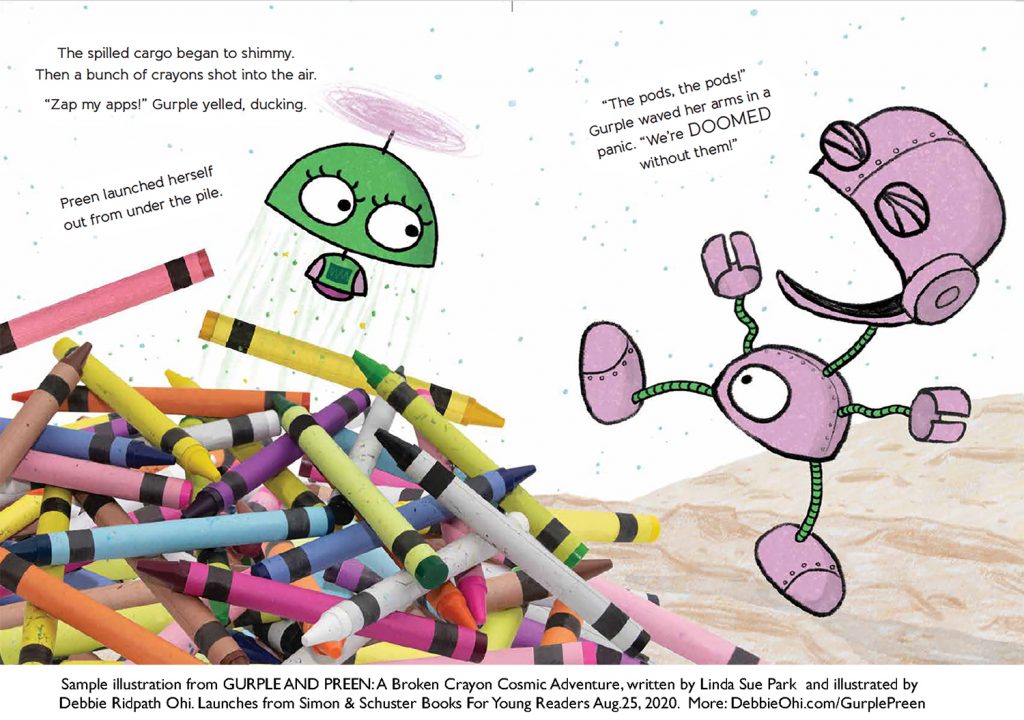
JB: Tell about one hurdle you experienced in the creation of Gurple and Preen or provide a memorable (or humorous!) anecdote related to the making of this book.
DRO: I went through hundreds (491, to be exact) of crayons in the making of this book. I love Crayola crayons, so it was a glorious chaos of color everywhere for many months! Emphasis on the chaos. My illustrations for Gurple and Preen use a combination of photographed elements (the crayons) as well as digital and real-life illustrations.
There were many piles of crayons throughout the book, but in order to keep the crayons from all rolling away randomly, I used glue to create the various piles. After the photo session, though, I was faced with the challenge of where to keep all the crayon sculptures. I didn’t want to get rid of them in case I needed to do any of the photography again, but they took up a LOT of room, and my office is NOT very big.
Still….looking at all those crayons everywhere in my office throughout the illustration process did make me happy.
LSP: The process for this story was, as Debbie pointed out, very different from any of my other books. This time, it was the illustrative concept that was leading the narrative. So for a while, I got ‘stuck’ there: I wrote scene after scene in which crayons kept breaking, and there wasn’t a strong story line. Editor Justin Chanda kept prodding me to prioritize the story, and he reminded me that Debbie would take care of the broken crayons in the illustrations. It took several drafts, but it was worth it—I love the story we ended up with, and it’s a true collaboration between author and illustrator.
One more thing: I had written the ending of the story, but I felt it still needed something more. I showed the story to author/illustrator Grace Lin to get her feedback. The final wordless spread, of the child in the bedroom? That was Grace’s suggestion. And Debbie made it super fun by including objects from the story for readers to find.
JB: What did you learn from creating Gurple and Preen?
DRO: How much I love crayons. You’d think I’d be tired of them after working with so many of them for so long, but I’ve actually become a little bit obsessed. When my husband and I went to Europe last year, I looked for crayons! I quite liked the crayons that Giotto makes.
But my favorite crayons are still Crayola, because they’re so affordable and come in so many wonderful colors.
Something non-art related that I appreciate with every book: how much I love learning through creative collaboration. I learned so much from Linda Sue as well as my art director, Laurent Linn, and editor Justin Chanda.
LSP: We hit one snag in the story. In addition to the robots, the other characters were a flock of quails and a monkey, because originally I had wanted to use animals that had actually been in space. The animals were anthropomorphized: Within limitations, they acted like humans. But I was starting to learn from reading Edith Campbell’s work that there is a history of racism informing the depiction of monkeys and apes in children’s books. I consulted Campbell, who pointed out that the monkey was the only animal with humanized facial expressions—and that was a problem. So, again working with Debbie, we decided to change the monkey to another animal, and eventually settled on a panda. I was very glad to learn from Campbell’s work and make this change.
JB: What would surprise readers to learn about you or about the creation of Gurple and Preen?
DRO: I only found this out from our agent, but apparently Linda Sue tried to get my name listed first on the cover! She said it was my broken crayons that began it all. She was (nicely) turned down, simply because it would confuse things for cataloging the book. Still, I thought it was incredibly sweet, plus it showed how much Linda Sue respects illustrators.
JB: What do you hope readers will take away from Gurple and Preen?
DRO: I’m hoping it helps show how much more effective it is to be proactive about DOING something to improve a situation rather than just complaining.
LSP: In this story, we see how Preen repurposes and reuses the objects that emerge from the broken crayons. I see kids do this all the time, with toys and ordinary household items; they have more flexible and agile minds than most adults. I believe that reusing and recycling are part of the key to saving the planet, and I hope this story helps reinforce that concept for young readers.
JB: How do you see Gurple and Preen connecting to curriculum?
DRO: Educational consultant and author Marcie Colleen wrote a wonderful classroom guide for Gurple and Preen that educators will find useful, designed for students in preschool through third grade. Find it here.
JB: What is one question you wish I had asked, and what is your answer?
DRO: What is your favorite colour of crayon?
Answer: Purple
LSP: What do you like most about Debbie’s broken-crayon art?
Answer: Usually when you break a crayon, it’s a mistake, a disappointment. I love how Debbie has turned that into something creative, imaginative, and fun!
Over to You…
Join the conversation! Offer your thoughts on the featured question related to this month’s post. You are also welcome to post a general comment.
What is your favorite illustration in Gurple and Preen?
Book and Signed Bookplate Giveaway!
Subscribers will be entered in a drawing to win a copy of Gurple and Preen, courtesy of Simon and Schuster Books for Young Readers, AND a bookplate signed by the author and illustrator! A winner will be chosen randomly and announced in my next blog post. Good luck!
News & Updates
Wear Your Masks, cont’d: School Library Journal has put together a list places to shop for “Face Masks Kids and Adults Will Want to Stick Their Noses In” featuring such book-loving categories as comics-style masks, Disney characters, Mo Willems’ Pigeon, Jeff Kinney’s Diary of a Wimpy Kid, and more.
In her July 29th blog post “Engaging Young People through Read-Alouds” for Curriculum Connections in School Library Journal, Donalyn Miller references a Literacy Leadership Brief published by the International Literacy Association: “Effective read-alouds increase children’s vocabulary, listening comprehension, story schema, background knowledge, word recognition skills, and cognitive development.” Miller goes on to offer insights, advice, and timely reminders of the value of reading aloud to children whether in-person or online.
Linda Sue Park participated on a panel with nine other children’s writers and illustrators of color to discuss how personal experiences with racism inform their art. This timely webinar entitled, “Sticks and Stones and the Stories We Tell: Children’s Book Creators on Channeling Random Acts of Racism” is produced by the Society of Children’s Book Writers and Illustrators (SCBWI) and is available for a limited time here. Find resources for sharing outstanding children’s books by author and illustrators of color on my June 2020 blog post.
I’m over the moon about my new website! It was designed by the talented and smart Jim Gubiotti at Nothing But Net Solutions. To celebrate its launch, I’m offering the chance to win an advanced reader copy (ARC) of The Mystery of the Barking Branches and the Sunken Ship, the first book in my new chapter book series, The Cayuga Island Kids. Sign up for my newsletter to enter.
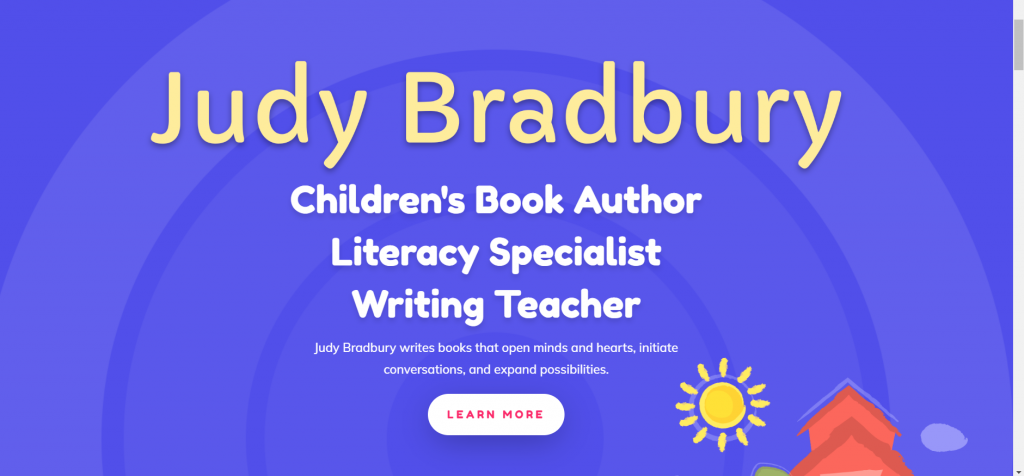

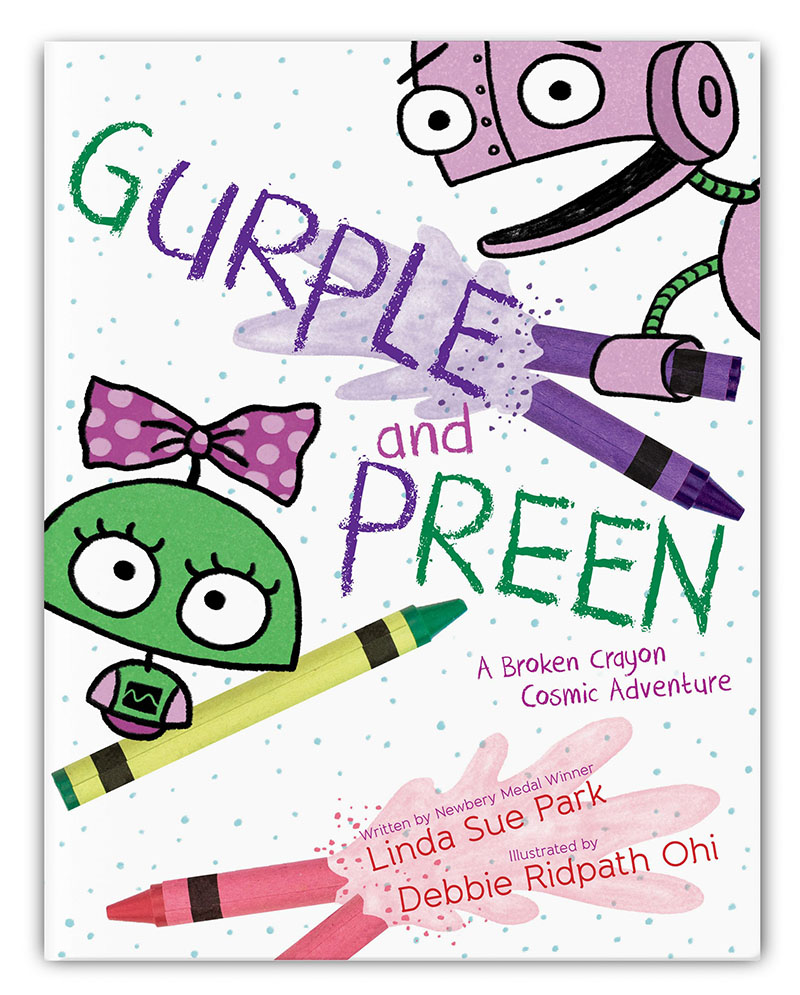
I remember as a kid being heartbroken when the first crayon in my new box got broken. But by the second or third, I felt liberated and happily colored away. I enjoyed hearing how Debbie and Linda Sue connected and then created this inventive, fun story together. Great interview with interesting questions and thoughtful answers. My thanks to you all.
I love this recollection, Marsha! Thanks for sharing it. We loved our boxes of crayons as kids! I remember the three-tiered boxes as being especially prized. Thanks for your comment. It’s always a pleasure hearing from you.
My mom told me as soon as I was old enough for crayons, I went for the purple one and ignored all the rest until my purple was gone. I colored everything purple. Even today, my bedroom walls are purple. thank you for the interview!
Purple! That’s the favorite color of Maya, a character in my upcoming Cayuga Island Kids chapter book series. Good to hear from you, Danielle!
I love the idea of mistake–or opportunity. This book looks like so much fun.
I agree, Vivian! This is one of the reasons I was drawn to this book.
What a great write up and interview Judy! Loved reading it and loved seeing Debbie’s inspiration for the book and the team work between Debbie and Linda Sue to create such a wonderful story.